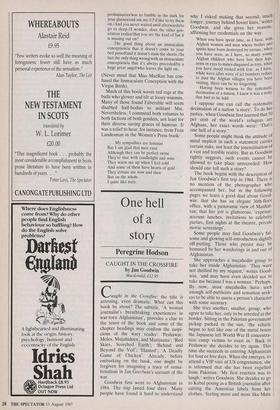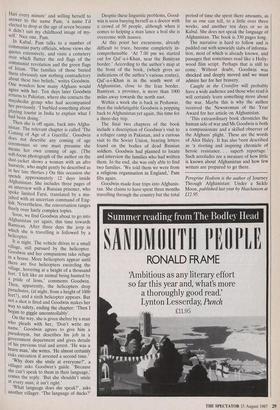One hell of a story
Peregrine Hodson
CAUGHT IN THE CROSSFIRE by Jan Goodwin
Macdonald, .02.95
Caught in. the Crossfire: the title is arresting, even dramatic. What can this book be about? The subtitle, 'A woman journalist's breathtaking experiences in war-torn Afghanistan', provides a clue to the tenor of the book and some of the chapter headings may confirm the suspi- cions of the wary reader: 'Peshawar: Moles, Mujahideen, and Marijuana'; 'Red Skies, Scorched Earth'; 'Behind and Beyond the Veil'; 'Hunted': 'A Deadly Game of Chicken'. Already, before embarking on the book, one might be forgiven for imagining a trace of sensa- tionalism in Jan Goodwin's account of the war.
Goodwin first went to Afghanistan in 1984. The trip lasted four days. 'Many people have found it hard to understand
why I risked making that second, much longer, journey behind Soviet lines,' writes Goodwin, and she gives her reasons, affirming her credentials on the way.
When you have spent time, as I have, with Afghan women and men whose bodies and spirits have been destroyed by torture, when you have seen, as I have, so many young Afghan children who have lost their legs, arms or eyes to mines disguised as toys, when you have stood rooted with fear, as I have. while wave after wave of jet bombers reduce to dust the Afghan villages you have been visiting, there can be no forgetting. Having been witness to the systematic that had tob
ofeatonladt.ion, I knew it was a story h I suppose one can call the systematic decimation of a nation 'a story'. To do her justice, when Goodwin first learned that 50 per cent of the world's refugees are Afghans, her exact words were: `That's one hell of a story.'
Some people might think the attitude of mind implicit in such a statement carries certain risks, not least the journalisation of a vast and terrible reality. But as Goodwin rightly suggests, such events cannot be allowed to take place unrecorded. How should one tell such a story?
The book begins with the description of Jan Goodwin's first trip in 1984. There is no mention of the photographer who accompanied her, but in the following pages we learn a good deal about Good- win: that she has an elegant 36th-floor office, with a panoramic view of Manhat- tan; that her job is glamorous, 'expense- account lunches, invitations to celebrity parties, first nights at the theatre, private movie screenings'. Some people may find Goodwin's ful- some and glowing self-introduction slightly off-putting. Those who persist may be bemused by her wanderings in and out of Afghanistan.
She approaches a mujahedin group to take her inside Afghanistan. 'They were not thrilled by my request,' writes Good- win, 'and may have even decided not to take me because I was a woman.' Perhaps. By now, most mujahedin have seen enough self-publicists and sensation seek- ers to be able to assess a person's character with some accuracy.
She tries another, smaller, group, who agree to take her, only to be arrested at the border. Sitting in the Pakistan government pickup parked in the sun, the vehicle began to feel like one of the metal boxes the Japanese left World War II concentra- tion camp victims to roast in.' Back in Peshawar she decides to try again. This time she succeeds in entering Afghanistan for four or five days. When she emerges, to attend a VIP visit of US congressmen, she is informed that she has been expelled from Pakistan. 'My first reaction was to laugh,' writes Goodwin. She decides to go to Kabul posing as a British journalist after cutting the American labels from her clothes, 'feeling more and more like Mata
Hari every minute' and willing herself to answer to the name Pam, 'a name I'd elected to drop at the age of seven because it didn't suit my childhood image of my- self.' Nice one, Pam. In Kabul, Pam talks to a number of communist party officials, whose views she quotes extensively, and visits a cemetery over which flutter the red flags of the communist revolution and the green flags of Islam. 'The families of those buried there obviously saw nothing contradictory about these two beliefs,' writes Goodwin. One wonders how many Afghans would agree with her. Ten days later Goodwin returns to Pakistan, where she contacts the mujahedin group who had accompanied her previously. burbled something about playing tourist in India to explain what I had been doing.' Then she is off again, back into Afgha- nistan. The relevant chapter is called 'The Coming of Age of a Guerilla'. Goodwin does not describe any coming of age ceremonies so one must presume she means her own coming of age. (The soft-focus photograph of the author on the dust-jacket shows a woman with an afro hairstyle, who might gently be described as in her late thirties.) On this occasion she spends approximately 12 days inside Afghanistan. She includes three pages of an interview with a Russian prisoner, who spoke limited Farsi, translated by a mu- jahed with an uncertain command of Eng- lish. Nevertheless, the conversation ranges freely over fairly complex topics. Soon, we find Goodwin about to go into Afghanistan yet again; this time towards Bamiyan. After three days the jeep in which she is travelling is followed by a helicopter.
It is night. The vehicle drives to a small village, still pursued by the helicopter. Goodwin and her companions take refuge in a house. More helicopters appear until there are five helicopters encircling the village, hovering at a height of a thousand feet. 'I felt like an animal being hunted by a pride of lions,' comments Goodwin. Then, apparently, the helicopters drop parachutes, (at night, from a height of 1000 feet?), and a sixth helicopter appears. But not a shot is fired and Goodwin makes her way to safety, ending the chapter: 'Then I began to giggle uncontrollably'. On the way, she is given shelter by a man who pleads with her, 'Don't write my name.' Goodwin agrees to give him a pseudonym, but describes his job in a government department and gives details of his previous trial and arrest. 'He was a brave man,' she writes. 'He almost certainly risks execution if arrested a second time.'
`Why does she smile at everyone?', a villager asks Goodwin's guide. 'Because she can't speak to them in their language,' comes the reply. 'But she shouldn't smile at every man; it isn't right.' 'What language does she speak?', asks another villager. 'The language of ducks?' Despite these linguistic problems, Good- win is soon busying herself as a doctor with a crowd of 50 people, although when it comes to helping a man lance a boil she is overcome with nausea.
At this point her excursions, already difficult to trace, become completely in- comprehensible. 'At 7.00 pm we started out for Qal'-a-i-Khan, near the Bamiyan border.' According to the author's map at the front of the book, (which gives no indications of the author's various routes), Qal'-a-i-Khan is in the south west of Afghanistan, close to the Iran border. Bamiyan, a province, is more than 1000 miles away towards the north east.
Within a week she is back in Peshawar, then the indefatigable Goodwin is popping back to Afghanistan yet again, this time for a three-day trip.
The final two chapters of the book include a description of Goodwin's visit to a refugee camp in Pakistan, and a curious visit to the Soviet Union, bearing letters found on the bodies of dead Russian soldiers. Goodwin had planned to locate and interview the families who had written them. In the end, she was only able to find two families. 'We told them we were from a religious organisation in England,' Pam fibs again.
Goodwin made four trips into Afghanis- tan. She claims to have spent three months travelling through the country but the total period of time she spent there amounts, as far as one can tell, to a little over three weeks, and another ten days or so in Kabul. She does not speak the language of Afghanistan. The book is 330 pages long.
The narrative is hard to follow and is padded out with unwieldy slabs of informa- tion, most of which is already known, and passages that sometimes read like a Holly- wood film script. Perhaps that is still to come. Without doubt, Goodwin was shocked and deeply moved and we must admire her for her bravery.
Caught in the Crossfire will probably have a wide audience and those who read it will certainly learn something more about the war. Maybe this is why the author received the Newswoman of the Year Award for her article on Afghanistan.
'This extraordinary book chronicles the human side of war and Ms Goodwin is both a compassionate and a skilled observer of the Afghans' plight.' These are the words of Alex Haley. It has also been described as 'a riveting and inspiring chronicle of heroic resistance. . . superb reportage.' Such accolades are a measure of how little is known about Afghanistan and how few writers are prepared to go there.
Peregrine Hodson is the author of Journey Through Afghanistan: Under a Sickle Moon, published last year by Hutchinson, at £12.95.



















































 Previous page
Previous page